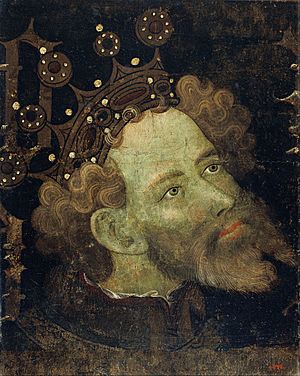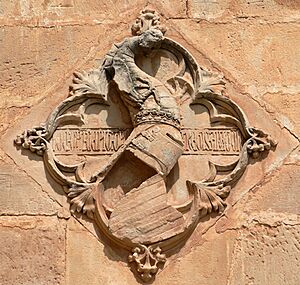Peter IV of Aragon facts for kids
Quick facts for kids Peter IV |
|
|---|---|

Peter IV, King of Aragon by Gonçal Peris Sarrià & Jaume Mateu (1427)
|
|
| King of Aragon (more...) | |
| Reign | 24 January 1336 – 6 January 1387 |
| Coronation | 1336 (Zaragoza) |
| Predecessor | Alfonso IV |
| Successor | John I |
| Born | 5 September 1319 Balaguer |
| Died | 6 January 1387 (aged 67) Barcelona |
| Spouse |
|
| Issue among others... |
|
| House | Barcelona |
| Father | Alfonso IV of Aragon |
| Mother | Teresa d'Entença |
| Religion | Roman Catholicism |

Peter IV (born September 5, 1319 – died January 6, 1387) was a powerful king who ruled Aragon from 1336 until his death. He was known as the Ceremonious because he liked to follow traditions and rules.
Peter IV was not just King of Aragon. He was also King of Sardinia and Corsica (as Peter I), King of Valencia (as Peter II), and Count of Barcelona (as Peter III). In 1344, he took over the Kingdom of Majorca from James III of Majorca.
His time as king was busy. He worked hard to make the crown stronger against the nobles who often rebelled. He also fought many wars in places like Sardinia, Sicily, Greece, and the Balearic Islands. His wars in Greece even made him the Duke of Athens and Neopatria in 1381.
Contents
Becoming King and Early Challenges
Peter was born in Balaguer. He was the oldest son of Alfons IV, who was then the Count of Urgell. Peter was set to inherit all of his father's titles, except for Urgell, which went to his younger brother, James.
When Peter became king after his father died, he held a special meeting called a corts in Zaragoza for his coronation. He crowned himself, which was a bit unusual. This showed that he wanted to be independent from the Papacy. Even though he crowned himself, he still promised to protect the rights and freedoms of Aragon.
While in Zaragoza, people from Castile asked him to keep the land gifts his father had given to his stepmother, Eleanor. Peter didn't give a clear answer.
After the coronation, Peter traveled to Valencia for another ceremony. On the way, he stopped in Lleida to confirm the laws of Catalonia. This upset the people of Barcelona, who usually hosted this ceremony. Peter said Lleida was just on his way. In Valencia, he decided that his stepmother, Eleanor, would lose her income. But Eleanor had many supporters, so Peter had to change his mind. In 1338, with the help of the Pope, Eleanor got her land rights back.
Taking Over Majorca
Early in his rule, Peter had problems with James III of Majorca. James was Peter's brother-in-law and was supposed to show loyalty to Peter as his ruler. But James kept putting off this ceremony. Majorca's businesses were growing fast, and its merchants were becoming very successful. This worried Peter, as it threatened the power of Barcelona.
James also made friends with the king of Morocco, who was Peter's enemy. Peter was very angry, but he didn't act until 1341. James was being threatened by France and asked Peter for help. Peter used this chance to declare that James was no longer his loyal subject.
Peter then started a legal case against James. He said that James printing his own money in certain areas was against the king's rights. The Pope tried to help them make peace, but Peter spread rumors that James wanted to capture him. James, fearing an invasion, went back to Majorca to get ready for a fight. In February 1343, Peter declared that James had lost his kingdom and lands.
Peter then went to war. In May, his fleet landed in Majorca and quickly defeated James's army. Peter took control of all the Balearic Islands. James tried to make peace, but Peter was ready to invade other areas James controlled. After these lands were taken in 1344, James gave up. Peter declared that Majorca would be part of the Crown of Aragon forever.
Important Battles and Challenges
Peter IV had to help Alfonso XI of Castile in his successful attack on Algeciras in 1344. He also helped in a failed attempt to take Gibraltar in 1349, defending against attacks from Morocco.
Peter didn't have any sons for a long time, so his brother, James, was next in line to the throne. Peter started to distrust James. He wanted his daughter, Constance, to be his heir instead, even though women usually didn't inherit the throne. He asked James to give up his important role as "procurator general," which was usually for the second in line.
James ran to Zaragoza and found support from nobles who wanted more power. Peter had to give in and make many promises to calm the rebellion. He agreed to let James be procurator general again and not name Constance as his heir. Peter then left, saying he had to deal with problems in Sardinia. Soon after, James suddenly died. Many people thought Peter had him poisoned. Without their leader, the nobles' rebellion became much weaker.
Peter then went to Valencia, where a similar group of nobles, called the Valencian Union, had formed. In Sagunt, Peter was forced to name his stepbrother Ferran as the new procurator general. He had to give up more royal power. This time, when he tried to leave, Peter was held prisoner in Valencia by the Union. He was even forced to dance with common people to show he was under their control.
Luckily for Peter, the Black Death arrived in Valencia in May 1348. This terrible plague allowed Peter to escape in the confusion. He gathered an army of loyal supporters and attacked the Union forces at the Battle of Epila on July 21, 1348. Peter won a complete victory. He went to Zaragoza and only punished thirteen Union leaders. This was seen as very kind for that time. In Valencia, many people were punished. Peter had the bell that the Valencian Union used for their meetings melted down.
From 1356, Peter fought a war with Peter I of Castile, called the "War of the Two Peters". It ended in 1375 without a clear winner, partly because of the Black Death and other natural disasters.
In 1349, James, the former King of Majorca, tried to invade Majorca again but was defeated and died in the Battle of Llucmajor. After James's death, Peter allowed James's son, James IV, to keep his royal title in name only until he died in 1375. After that, Peter officially took the title. Majorca remained part of the Crown of Aragon.
Peter died in Barcelona when he was 67 years old.
The Generalitat
At a special meeting held in Barcelona, Vilafranca del Penedès, and Cervera in 1358–1359, Peter created the Generalitat. This happened because Castile had recently invaded Aragon and Valencia. The meeting decided to make the government more efficient. They chose a group of twelve deputies to manage the money and resources of the Crown. The first "President of the Generalitat" was Berenguer de Cruïlles, who was the Bishop of Girona.
Towards the end of his rule, around 1370, Peter ordered a book called the Chronicle of Sant Joan de la Penya to be written. This book recorded the history that supported the power of the king.
Peter and the Jewish Community
There is a story about Peter IV and his Jewish doctor. They had a friendly discussion about why Jewish people were not allowed to drink kosher wine that a Christian had touched. The doctor then had water brought to wash the king's feet. He then drank that water to show that the rule was not about fear of being unclean.
Family Life
Peter IV was married four times and had several children.
His first marriage was on July 23, 1338, to Maria of Navarre (1329 – April 29, 1347). They had four children:
- Constance (1343 – July 1363), who married King Frederick III of Sicily.
- Joanna (November 7, 1344 – 1385).
- Maria (1345/6 – June 3, 1348).
- Peter (born and died April 28, 1347).
His second marriage was on November 15, 1347, to Eleanor (1328 – October 29, 1348). She died just one year later from the Black Death.
His third marriage was on August 27, 1349, to Eleanor (1325 – April 20, 1375). They had four children:
- John I (December 27, 1350 – May 19, 1396).
- Martin I (1356 – May 31, 1410).
- Eleanor (February 20, 1358 – September 13, 1382), who married John I of Castile. She was the mother of Ferdinand I of Aragon.
- Alfonso (May or June 1362 – 1364).
His last marriage was on October 11, 1377, to Sibila (? – November 4 or 24, 1406). They had three children:
- Alfonso (1376 – 1377), who became Count of Morella.
- Peter (born and died April 1379).
- Isabella (1380 – 1424). She married Count James II of Urgell. Through Isabella, Peter and Sibila are ancestors to Joana, Princess of Portugal and John II of Portugal.
See also
 In Spanish: Pedro IV de Aragón para niños
In Spanish: Pedro IV de Aragón para niños


